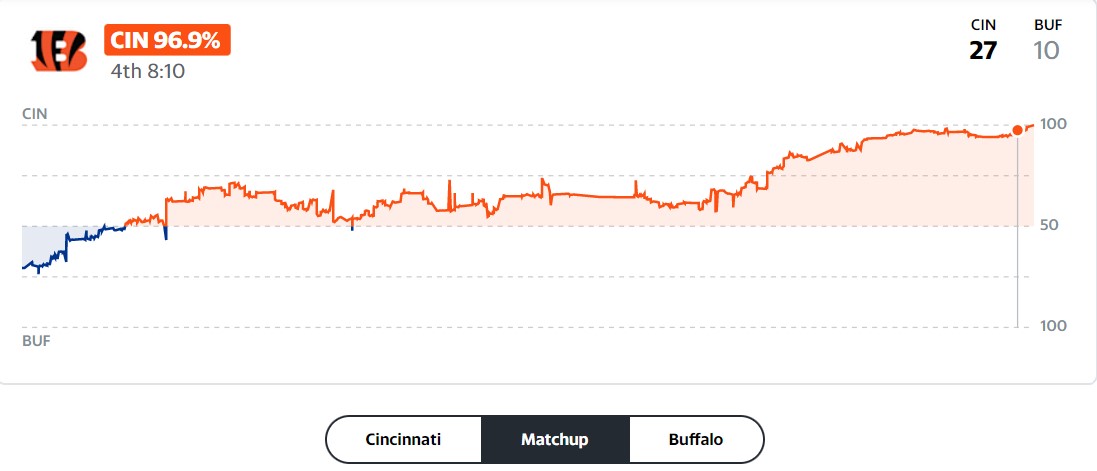The Importance of Scenarios When Facing Poor Odds of Success
American football is experiencing a data analytics movement. One of the most visible signs of this movement is the National Football League’s (NFL) partnership with Amazon AWS to create “Next Gen Stats” and “Stat That.” NFL coaches are also apparently increasingly turning to “the analytics” to make game critical decisions. Announcers and fans alike endlessly debate the merits of using soulless computers versus well-trained human instincts to make these decisions. During the 2023 AFC Divisional playoffs featuring the Cincinnati Bengals at the Buffalo Bills, the Bills faced a set of low probability win scenarios that garnered no debate on-air. I agreed with the Bills’ choice to select the most aggressive option. A friend of mine preferred the most conservative approach. I dedicate this post to him to document my logic.
The Scenarios
With just under 8 minutes left to play in the game, the Buffalo Bills stared down a fourth down with 6 yards to go for a first down, about 18 yards to go for a touchdown, and a seemingly insurmountable 27-10 deficit. The Bengals dominated and outplayed the Bills for the vast majority of the game, so scoring three times in quick succession to lead to victory had extremely low odds. The near-zero chance is reflected in the analytics provided by Yahoo Sports. The chart below shows that Cincinnati had about a 97% chance of winning around the 8-minute mark. So no alternative available to McDermott could have had more than a 3% chance of leading to a win.

In isolation, the analytics agree with my friend. Given no other context, a team should kick the field goal when faced with a 4th and 6 with 18 years to the end zone. However, context and scenarios matter a lot here. After a successful field goal, the Bills would still need two touchdowns to have a chance of winning. Given the team only managed a single touchdown to this point, the prospects of marching down the field two more times for touchdowns might as well have been zero. Moreover, given the limited time remaining in the game, at least one touchdown would depend on a successful onside kick (where the kicking team tries to retain possession by capturing the ball after a 10-yard kick). Teams have an overall 13.2% success rate for recovering an onside kick.
So, the key question facing McDermott was whether the Bills were more likely to score a touchdown from their current position or after having kicked a field goal? Conditioned this way, the odds seem to favor McDermott’s decision to keep playing for more yards or a touchdown.
Kicking a 35-yard field goal (add 17 yards to the line of scrimmage at the 18-yard line), even in the snowy conditions, had high odds of success. Bills kicker Tyler Bass made his only kick of the day, a 25-yarder. Over the course of the season, Bass made 11 of 13 (85%) field goals between 30 and 39 yards. So it is understandably tempting to go for the sure thing and keep hope alive. However, recent NFL history shows a 43% chance of converting a fourth down and 6 into a first down and a fresh set of 4 downs to play with (in 2022, the Bills had an overall 53.8% conversion rate). Interestingly, the overall odds for a touchdown from this distance are about 50% according to older research. I have to assume that the odds are even better in today’s offense-friendly NFL.
Of course, given the way the Bengals dominated the Bills, all first down and touchdown odds for this particular game were notably lower. Still, the odds of a positive outcome from playing fourth down still looked much better than a well-anticipated onside kick. Thus, kicking a field goal in that spot scenario was simply too conservative.
The Agreement from the Announcer’s Booth
The decision seemed clear enough that the announcers in the booth did not even evoke analytics or computers. Former Dallas Cowboys QB Tony Romo did not hesitate in concluding “yeah, I’m going for this right now…it’s hard to move up and down the field over and over again. You gotta go on this.” Context matters in these decisions, and Romo instinctively understood the scenarios at play. It was “do or die” time for the Bills. Kicking a field goal to get the chance at an even lower probability of success did not make sense. If the Bills could not score a touchdown at this point, they simply had no chance of scoring two touchdowns in the next 7 minutes or so.
The Outcome
Well, McDermott did not hesitate. Bills quarterback Josh Allen stepped back, looked and looked and looked, and finally threw a weak pass to Gabe Davis in the endzone that defender Eli Apple easily knocked down. The Bengals took over on downs and did not return the ball to the Bills until the 2:32 mark. That Bengals drive further validated the notion that the Bills could only score two touchdowns after a field goal with at least one recovery of an onside kick. The Bengals were able to keep driving down the field on the Bills.

With a failed attempt at a touchdown, it is tempting to conclude that the Bills should have kicked the field goal. However, the outcome of a decision does not determine its quality. Instead, the context at the time of the decision determines the quality. In this case, the context was defined by the conditional scenarios at work: try a field goal and figure out the impossibility of scoring two more touchdowns or try to score a touchdown now and shorten the subsequent yards needed for one more touchdown and a field goal. These are the scenarios that require hope beyond hope to summon a potential winning strategy!
